Abstract
When propranolol is given to prevent hypoxaemic episodes in children with tetralogy of Fallot who are awaiting operation it is advisable to continue the treatment until shortly before the induction of anaesthesia. Because catecholamines are often required to maintain adequate cardiac output after surgical correction the effect of preoperative treatment with beta blockers on the response to isoprenaline after the operation was investigated in nine children given propranolol before operation and nine who were not. They were studied three and 24 hours after cardiopulmonary bypass. The haemodynamic response to increasing doses of infused isoprenaline was monitored. Immediately after cardiopulmonary bypass the response to isoprenaline was significantly blunted in the patients who had been given propranolol before operation. Their dose-response curve lay to the right of that for patients not given propranolol, and this indicates competitive inhibition. Propranolol concentrations in the blood and myocardium correlated significantly with the heart rate response to isoprenaline. Twenty four hours after operation the isoprenaline response was similar in both groups and concentrations of propranolol in the blood were minimal or undetectable. beta Blockers given up to the time of operation significantly altered the postoperative response to catecholamines.
Full text
PDF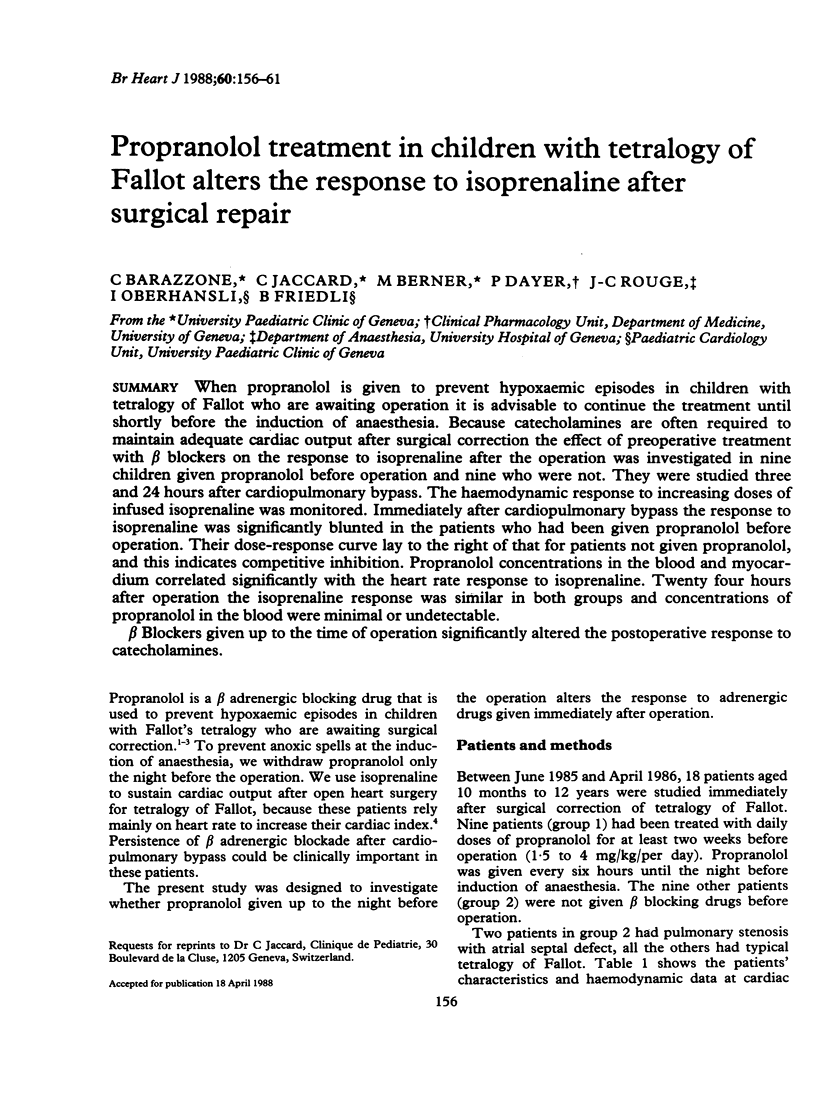
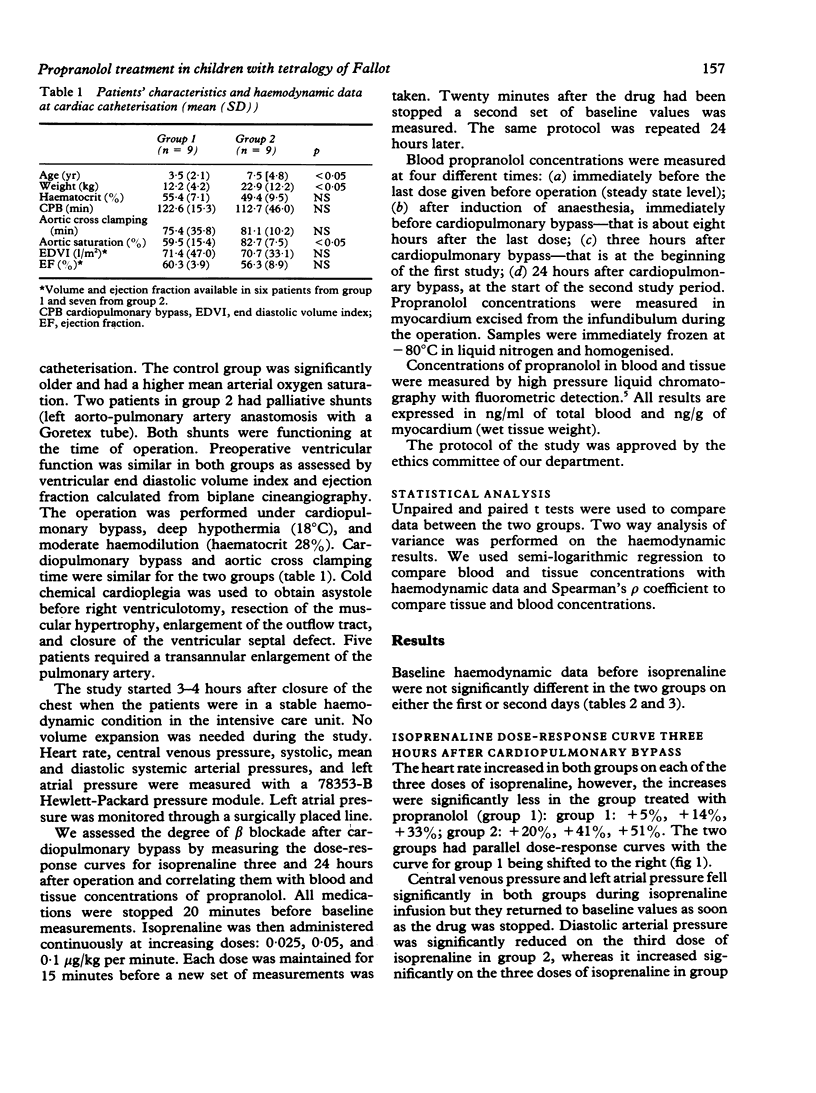
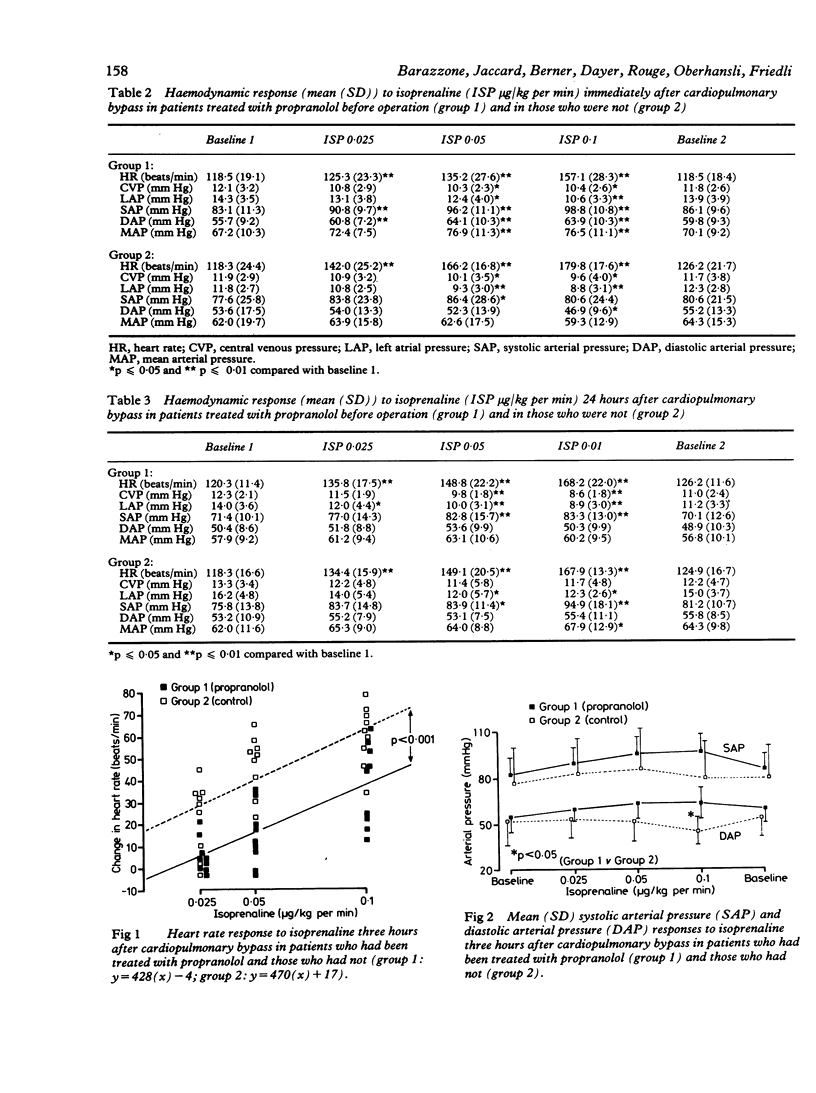

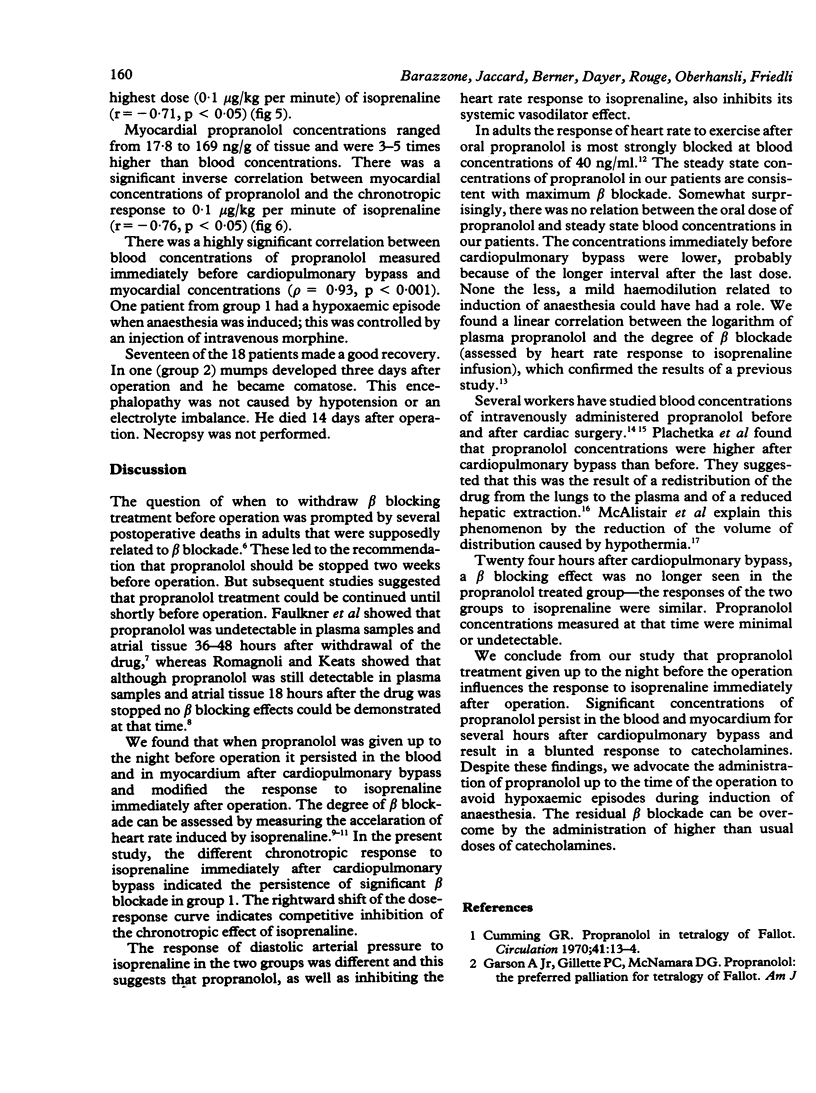
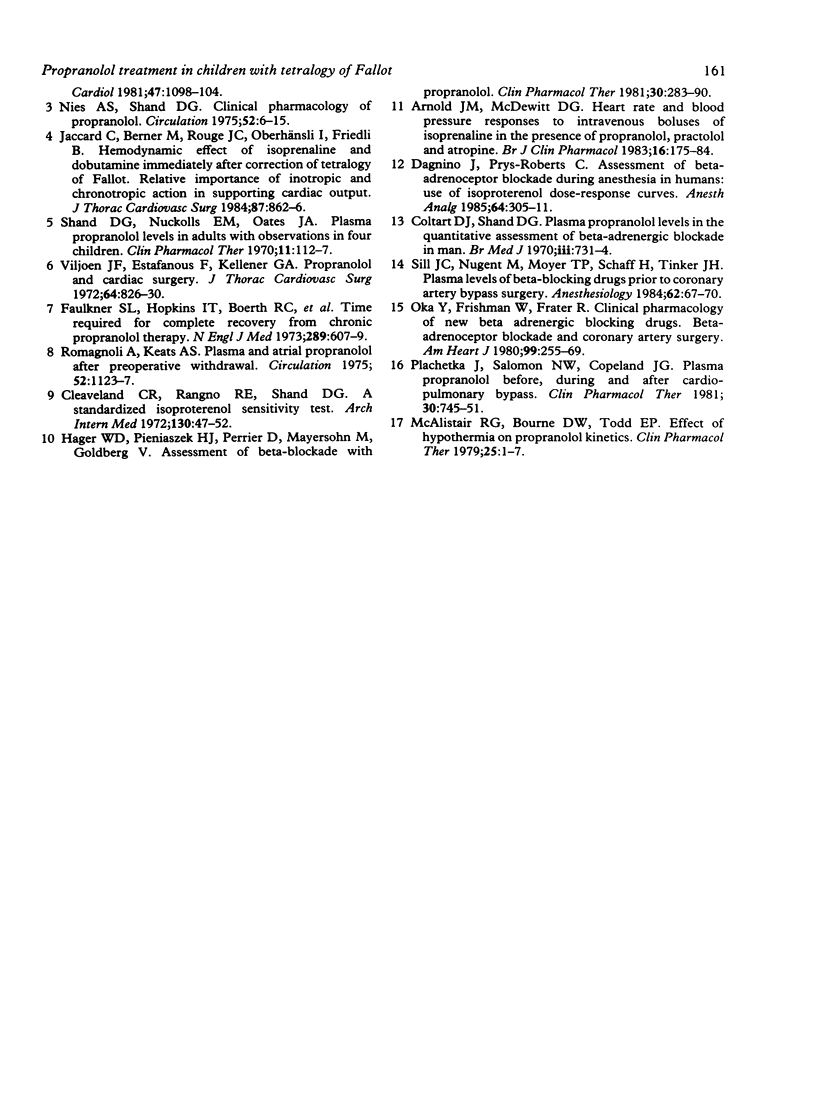
Selected References
These references are in PubMed. This may not be the complete list of references from this article.
- Arnold J. M., McDevitt D. G. Heart rate and blood pressure responses to intravenous boluses of isoprenaline in the presence of propranolol, practolol and atropine. Br J Clin Pharmacol. 1983 Aug;16(2):175–184. doi: 10.1111/j.1365-2125.1983.tb04982.x. [DOI] [PMC free article] [PubMed] [Google Scholar]
- Cleaveland C. R., Rangno R. E., Shand D. G. A standardized isoproterenol sensitivity test. The effects of sinus arrhythmia, atropine, and propranolol. Arch Intern Med. 1972 Jul;130(1):47–52. doi: 10.1001/archinte.130.1.47. [DOI] [PubMed] [Google Scholar]
- Coltart D. J., Shand D. G. Plasma propranolol levels in the quaniitative assessment of beta-adrenergic blockade in man. Br Med J. 1970 Sep 26;3(5725):731–734. doi: 10.1136/bmj.3.5725.731. [DOI] [PMC free article] [PubMed] [Google Scholar]
- Cumming G. R. Propranolol in tetralogy of Fallot. Circulation. 1970 Jan;41(1):13–15. doi: 10.1161/01.cir.41.1.13. [DOI] [PubMed] [Google Scholar]
- Dagnino J., Prys-Roberts C. Assessment of beta-adrenoceptor blockade during anesthesia in humans: use of isoproterenol dose-response curves. Anesth Analg. 1985 Mar;64(3):305–311. [PubMed] [Google Scholar]
- Faulkner S. L., Hopkins J. T., Boerth R. C., Young J. L., Jr, Jellett L. V., Nies A. S., Bender H. W., Shand D. G. Time required for complete recovery from chronic propranolol therapy. N Engl J Med. 1973 Sep 20;289(12):607–609. doi: 10.1056/NEJM197309202891204. [DOI] [PubMed] [Google Scholar]
- Hager W. D., Pieniaszek H. J., Jr, Perrier D., Mayersohn M., Goldberger V. Assessment of beta blockade with propranolol. Clin Pharmacol Ther. 1981 Sep;30(3):283–290. doi: 10.1038/clpt.1981.161. [DOI] [PubMed] [Google Scholar]
- Jaccard C., Berner M., Rouge J. C., Oberhänsli I., Friedli B. Hemodynamic effect of isoprenaline and dobutamine immediately after correction of tetralogy of Fallot. Relative importance of inotropic and chronotropic action in supporting cardiac output. J Thorac Cardiovasc Surg. 1984 Jun;87(6):862–869. [PubMed] [Google Scholar]
- McAllister R. G., Jr, Bourne D. W., Tan T. G., Erickson J. L., Wachtel C. C., Todd E. P. Effects of hypothermia on propranolol kinetics. Clin Pharmacol Ther. 1979 Jan;25(1):1–7. doi: 10.1002/cpt19792511. [DOI] [PubMed] [Google Scholar]
- Nies A. S., Shand D. G. Clinical pharmacology of propranolol. Circulation. 1975 Jul;52(1):6–15. doi: 10.1161/01.cir.52.1.6. [DOI] [PubMed] [Google Scholar]
- Oka Y., Frishman W., Becker R. M., Kadish A., Strom J., Matsumoto M., Orkin L., Frater R. Clinical pharmacology of the new beta-adrenergic blocking drugs. Part 10. Beta-adrenoceptor blockade and coronary artery surgery. Am Heart J. 1980 Feb;99(2):255–269. doi: 10.1016/0002-8703(80)90774-7. [DOI] [PubMed] [Google Scholar]
- Plachetka J. R., Salomon N. W., Copeland J. G. Plasma propranolol before, during, and after cardiopulmonary bypass. Clin Pharmacol Ther. 1981 Dec;30(6):745–751. doi: 10.1038/clpt.1981.233. [DOI] [PubMed] [Google Scholar]
- Romagnoli A., Keats A. S. Plasma and atrial propranolol after preoperative withdrawal. Circulation. 1975 Dec;52(6):1123–1127. doi: 10.1161/01.cir.52.6.1123. [DOI] [PubMed] [Google Scholar]
- Shand D. G., Nuckolls E. M., Oates J. A. Plasma propranolol levels in adults with observations in four children. Clin Pharmacol Ther. 1970 Jan-Feb;11(1):112–120. doi: 10.1002/cpt1970111112. [DOI] [PubMed] [Google Scholar]
- Sill J. C., Nugent M., Moyer T. P., Schaff H., Tinker J. H. Plasma levels of beta-blocking drugs prior to coronary artery bypass surgery. Anesthesiology. 1985 Jan;62(1):67–70. doi: 10.1097/00000542-198501000-00014. [DOI] [PubMed] [Google Scholar]
- Viljoen J. F., Estafanous F. G., Kellner G. A. Propranolol and cardiac surgery. J Thorac Cardiovasc Surg. 1972 Nov;64(5):826–830. [PubMed] [Google Scholar]


